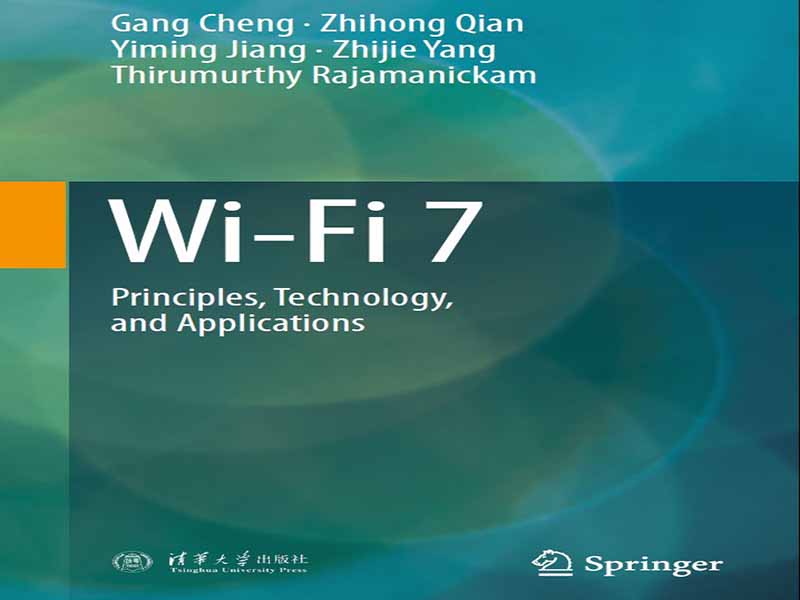- عنوان مجله: Wi-Fi 7 Principles, Technology, and Applications
- نویسنده: Gang Cheng, Zhihong Qian, Yiming Jiang
- حوزه: ارتباطات بیسیم
- سال انتشار: 2025
- تعداد صفحه: 483
- زبان اصلی: انگلیسی
- نوع فایل: pdf
- حجم فایل: 16.2 مگابایت
در عصر اینترنت فراگیر امروزی، وایفای موفقترین فناوری اتصال بیسیم داخلی است. با توجه به تجاریسازی گسترده آن، بسیاری تصور میکنند که فناوری وایفای به اوج بلوغ خود رسیده است. حتی متخصصان صنایع ارتباطات و کامپیوتر نیز ممکن است فرض کنند که پتانسیل دستنخورده کمی در فناوری وایفای باقی مانده است. واقعیت این است که فناوری وایفای با سرعتی ثابت، تقریباً دو برابر سریعتر از ارتباطات سیار، در حال تکامل بوده است و هر نسل جدید فناوری وایفای تجربیات کاربران را به طور قابل توجهی ارتقا میدهد. از زمان معرفی اولین استاندارد وایفای در سال ۱۹۹۷، استانداردهای جدیدی تقریباً هر چهار تا پنج سال ظهور کردهاند که هر کدام پیشرفتهای قابل توجهی در نرخ دادههای فیزیکی به همراه داشتهاند. این نرخها از سرعت اولیه ۲ مگابیت در ثانیه شروع شده و به تدریج به ۵۴ مگابیت در ثانیه، سپس به ۶۰۰ مگابیت در ثانیه افزایش یافته و اکنون با آخرین استاندارد وایفای ۷ از ۳۰ گیگابیت در ثانیه فراتر رفته است. در ادارات، وایفای به یک زیرساخت ضروری تبدیل شده است و در خانه، به اندازه آب، برق و گاز برای زندگی روزمره مردم ضروری شده است. طبق گزارش اتحادیه وایفای، ارزش اقتصادی جهانی وایفای در سال ۲۰۲۱، ۳.۳ تریلیون دلار تخمین زده شده است و انتظار میرود تا سال ۲۰۲۵ به ۴.۹ تریلیون دلار افزایش یابد. این رشد ناشی از افزایش تقاضا برای برنامههای کاربردی بلادرنگ با حجم داده بالا، تحول دیجیتال ارتباطات سازمانی و در دسترس بودن طیف جدید ۶ گیگاهرتز است که توسط بسیاری از کشورها و مناطق مجاز شده است. پس از بیش از دو دهه توسعه فناوری و تکامل استانداردها، وایفای امروزه به یکی از موتورهای اقتصادی اقتصاد دیجیتال تبدیل شده است. جدیدترین استاندارد وایفای، که توسط IEEE به عنوان ۸۰۲.۱۱be تعریف شده و توسط اتحادیه وایفای با نام تجاری وایفای ۷ شناخته میشود، نسل بعدی اتصال بیسیم را نشان میدهد. پیش از آن، وایفای ۶ اندکی پس از آنکه اتحادیه وایفای استاندارد آزمایش صدور گواهینامه را در سال ۲۰۱۹ تعیین کرد، بهطور گسترده توسط اپراتورهای مخابراتی، تولیدکنندگان روتر و سازندگان دستگاههای هوشمند پذیرفته شد. وایفای ۷، بهعنوان نسل بعدی فناوری وایفای، قصد دارد پهنای باند فوقالعاده بالا و عملکرد فوقالعاده بالایی را با نوآوریها و پیشرفتهای تکنولوژیکی بیشتر ارائه دهد. سرعت نظری وایفای ۷ از ۳۰ گیگابیت بر ثانیه فراتر میرود، بیش از سه برابر وایفای ۶، و همچنین از حداکثر سرعت ارتباطات موبایل ۵G فراتر میرود. جدیدترین مشخصات وایفای ۷ اخیراً توسط IEEE تصویب شده است. گوشیهای جدید به فناوری وایفای ۷ مجهز شدهاند و انتظار میرود میلیونها دستگاه با قابلیت وایفای ارتقا یافته، مشابه روندی که در هر استاندارد وایفای قبلی دیده میشود، وارد بازار شوند. بدون شک، وایفای ۷ در سالهای آینده و قبل از اینکه وایفای ۸ جای آن را بگیرد، بر ارتباطات کوتاهبرد در شبکههای خانگی، دفاتر بیسیم سازمانی و برنامههای وایفای عمومی تسلط خواهد یافت. عملکرد فوقالعاده بالای آن، خدمات مختلف حساس به تأخیر پهنای باند بالا، مانند ویدیوی با کیفیت بسیار بالا، بازیهای آنلاین و واقعیت مجازی را تسهیل میکند. کتابهای کمی در بازار در مورد اصول و شیوههای طراحی توسعه محصول Wi-Fi وجود دارد. این کتاب این شکاف را پر میکند و به عنوان یک منبع حرفهای جامع در صنایع مختلف در مورد فناوریهای کلیدی Wi-Fi 7، توسعه محصول Wi-Fi 7 و کاربردهای تجاری Wi-Fi 7، مانند ادغام فناوری جدید Wi-Fi با شبکههای تلفن همراه 5G و غیره، عمل میکند. این کتاب همچنین به علاقهمندان به فناوری Wi-Fi کمک میکند تا مفاهیم و اصول فنی پشت آموزش از راه دور، سرگرمی خانگی و سایر تجربیات زندگی را درک کنند. این کتاب به دو بخش اصلی تقسیم شده است. بخش اول با مفاهیم و اصول اولیه فناوری وایفای آغاز میشود و سپس به ترتیب به فناوریهای کلیدی و تغییرات استانداردی که وایفای ۶ و وایفای ۷ به ارمغان میآورند، میپردازد و درک عمیقی از جنبههای مختلف وایفای ۷ را در اختیار خوانندگان قرار میدهد. بخش دوم به بحث در مورد روشهای توسعه و آزمایش محصول مبتنی بر وایفای ۷ میپردازد، به بررسی استفاده از برنامههای وایفای ۷ در سناریوهای مختلف صنعتی یا خانگی و همچنین همگرایی فناوریهای موبایل وایفای ۷ و ۵G میپردازد. در پایان، این کتاب پیشبینی روندهای فناوری وایفای و تغییراتی را که در آینده برای عموم به ارمغان خواهد آورد، ارائه میدهد. این کتاب مقدمهای عمیق بر فناوری وایفای ۷ و همچنین توسعه محصولات جدید و کاربردهای کسب درآمد از وایفای توسط ارائهدهندگان خدمات ارائه میدهد. نویسندگان عبارتند از چنگ گانگ، کیان ژیهونگ، جیانگ ییمینگ، تیرومورتی راجامانیکام، در حالی که یانگ ژیجی یکی از نویسندگان اصلی نسخه چینی است که در سپتامبر ۲۰۲۳ منتشر شد. در مقایسه با نسخه چینی، بسیاری از فصلها دستخوش بازنگریهای گستردهای شدهاند که شامل اصلاح دقیق اصول وایفای، گنجاندن جدیدترین پیشرفتها در فناوری وایفای ۷ و اتخاذ رویکردی سیستماتیکتر و دقیقتر برای نشان دادن فناوریهای پیشرفته است.
In the ubiquitous Internet era nowadays, Wi-Fi is the most successful indoor wireless connectivity technology. Given its extensive commercialization, it is common for many to perceive Wi-Fi technology as having reached its peak maturity. Even professionals within the communications and computer industries may assume that there is little untapped potential left in Wi-Fi technology. The reality is that Wi-Fi technology has been evolving at a steady pace, nearly twice as fast as mobile communication, with each new generation of Wi-Fi technol- ogy significantly uplifting user experiences. Since the introduction of the first Wi-Fi standard in 1997, new standards have emerged approximately every four to five years, each bringing significant improvements in physical data rates. Starting from an initial speed of 2 Mbps, these rates have progressively increased to 54 Mbps, then to 600 Mbps, and now surpass 30 Gbps with the latest Wi-Fi 7 standard. In offices, Wi-Fi has become an essential infrastructure, and at home, it has become as indispensable as water, electricity, and gas for people’s daily lives. According to a Wi-Fi Alliance report, the global economic value of Wi-Fi was estimated at $3.3 trillion in 2021 and is expected to grow to $4.9 trillion by 2025. This growth is driven by the increasing demand for data-intensive real-time appli- cations, the digital transformation of enterprise communication, and the availability of new 6 GHz spectrum, which has been authorized by many countries and regions. After more than two decades of technological development and standard evolution, Wi-Fi has become one of the economic engines of the digital economy today. The newest Wi-Fi standard, defined by the IEEE as 802.11be and branded Wi-Fi 7 by the Wi-Fi Alliance, represents the next generation of wireless connectivity. Prior to it, Wi-Fi 6 was widely adopted by telecom operators, router manufacturers, and smart device makers soon after the Wi-Fi Alliance established the certification testing standard in 2019. As the next generation of Wi-Fi technology, Wi-Fi 7 aims to deliver ultra-high bandwidth and ultra-high performance, with more technological innovations and breakthroughs. The theoretical rate of Wi-Fi 7 exceeds 30 Gbps, more than three times that of Wi-Fi 6, and also exceeds the peak rate of 5G mobile communication. The latest Wi-Fi 7 specification has recently been ratified by the IEEE. The new handsets have been equipped with the Wi-Fi 7 technology, and millions of devices with the upgraded Wi-Fi capability are expected to hit the market, similar to the trend seen with every predecessor Wi-Fi standards release. Uncontroversially, Wi-Fi 7 will dominate short-range communication in home networks, enterprise wireless offices, and public Wi-Fi applications in the next years before Wi-Fi 8 takes over. Its ultra-high performance will facilitate various high-bandwidth latency-sensitive ser- vices, such as ultra-high definition video, online gaming, and virtual reality. There are few books on the market about the principles and design practices of Wi-Fi product development. This book fills that gap, serving as a comprehensive professional resource across industries regarding Wi-Fi 7 key technologies, Wi-Fi 7 product development, and Wi-Fi 7 business applications, such as the integration of new Wi-Fi technology with 5G mobile networks, etc. This book also helps those interested in Wi-Fi technology to understand the technical concepts and principles behind remote learning, home entertainment, and other life experiences. This book is divided into two main parts. The first part starts with the basic concepts and principles of Wi-Fi technology and then delves into the key technologies and standard changes that Wi-Fi 6 and Wi-Fi 7 bring, respectively, providing readers an in-depth understanding of various aspects of Wi-Fi 7. The second part discusses product development and testing methods based on Wi-Fi 7, explores utilizing Wi-Fi 7 applications in different industry or home scenarios, as well as the convergence of Wi-Fi 7 and 5G mobile technologies. At the end, this book provides a forecast on Wi-Fi technology trends and the changes it will bring to the public in the future. This book features an in-depth introduction to Wi-Fi 7 technology, as well as new product development and the Wi-Fi monetization applications of service providers. The authors are Cheng Gang, Qian Zhihong, Jiang Yiming, Thirumurthy Rajamanickam, while Yang Zhijie is one of the original authors of the Chinese edition, which was published in September 2023. Compared with the Chinese edition, many chapters have undergone extensive revisions, encompassing a metic- ulous refinement of Wi-Fi principles, the incorporation of the newest advancements in Wi-Fi 7 technology, and the adoption of a more systematic and precise approach to illustrate cutting-edge technologies.
این کتاب را میتوانید از لینک زیر بصورت رایگان دانلود کنید:



































نظرات کاربران